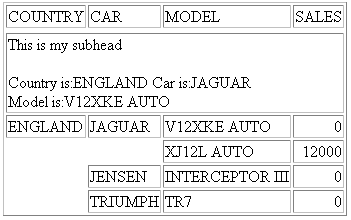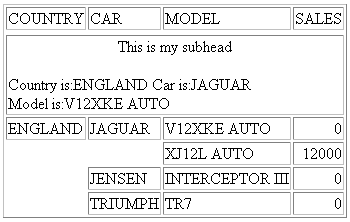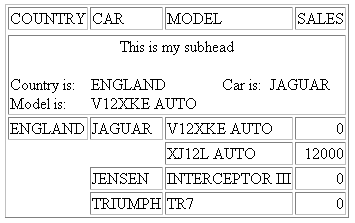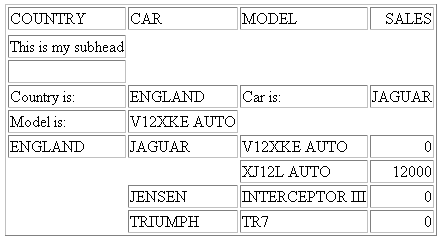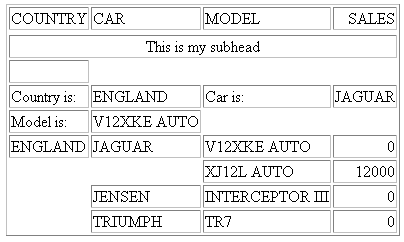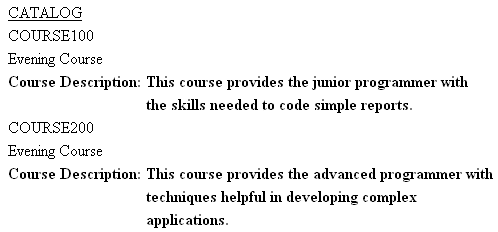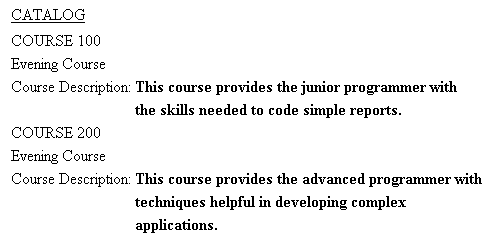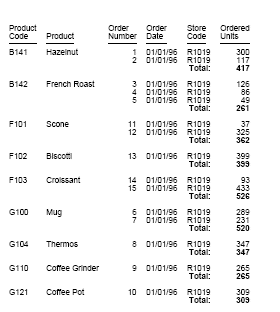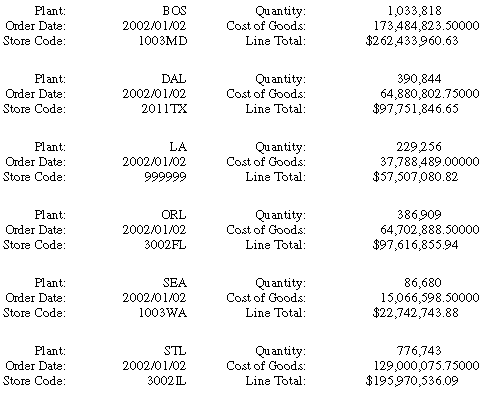How to: |
For HTML output (and for Excel 2000 output, which uses HTML alignment), you can position text and field items in headings and footings using HEADALIGN options. These options work within the limitations of HTML and browser technologies to provide a significant degree of formatting flexibility. Here is how HEADALIGN works.
For PDF output, you can use the HEADALIGN=BODY option to align heading and footing elements with the report body.
When HEADALIGN is set either to BODY or INTERNAL, output is laid out as an HTML table, which means that the browser determines the widths of the columns, thereby limiting the precise positioning of items. A basic rule governs the placement of heading or footing items: each item (text or embedded field) is placed in sequence into the next HTML table cell (<TD>). When HEADALIGN is set to NONE, the default, all the items in the heading or footing are strung together, inside a single cell. The browser stretches the heading table and the report table to accommodate the length of the text.
You can exercise control over the placement of items by overriding the default and choosing either BODY or INTERNAL:
- HEADALIGN=BODY puts heading item cells in the same HTML table as the body of the report, ensuring that the items in the heading and the data in the body of the report line up naturally since they have the same column widths. This is a simple and useful way to align heading items with columns of data. For example, suppose that you have computed subtotal values that you want to include in a sort footing. Using HEADLIGN=BODY, you can align the subtotals in the same columns as the data that is being totaled.
- HEADALIGN=INTERNAL puts the heading items in an HTML table of its own. This allows the heading items to be aligned vertically with each other, independent of the data, since the widths of the heading items do not affect the width of the report columns and vice versa.
To break a text string into multiple parts for manipulation across columns in an HTML table, you can use <+0> spot markers in the request.
You can use HEADALIGN options in conjunction with the COLSPAN attribute. COLSPAN allows heading items to span multiple table columns, thereby providing additional flexibility in how you can design your headings. For details, see Aligning a Heading or Footing Element in an HTML, EXL2K, or PDF Report.
If there is more than one heading or footing type in a report, you can individually align any element within each of them using this syntax.
TYPE = {REPORT|headfoot}, HEADALIGN = option, $where:
- REPORT
Applies the chosen alignment to all heading and footing elements in a report.
- headfoot
Is the type of heading or footing. Valid values are TABHEADING, TABFOOTING, HEADING, FOOTING, SUBHEAD, and SUBFOOT.
- option
Is the type of alignment. Valid values are:
NONE which places heading items in an embedded HTML table inside the main (body) table, and strings together, in a single cell of the embedded table, all the heading items (text and fields) on a line. In PDF reports, this uses the default alignment heading alignment. This value is the default.
INTERNAL which places heading items in an HTML table of its own, with each item in a separate cell. This allows the heading items to be aligned vertically with each other, independent of the data columns. The widths of the heading items do not affect the widths of the report columns and vice versa. Note: HEADALIGN=INTERNAL is not supported in PDF reports.
BODY which aligns heading items with data columns by placing the items in the cells of the same HTML table as the body of the report. Since they have the same column widths, the items in the heading and the data in the body of the report line up naturally. For PDF output, this aligns the heading or footing elements with the data columns. Note: HEADALIGN=BODY does not support paneling.
This request creates an embedded HTML table for a page heading, within the HTML table that governs alignment in the body of the report. This table has three rows and three columns to accommodate all the heading elements.
In the first line of the heading, a spot marker (<+0>) creates two text elements: the first element is blank, and the second element is Gotham Grinds, Inc. In the output, the second element appears in the second cell of the first row of the embedded table.
The second and fourth lines of the heading are blank.
The spot markers in the third line of the heading split it into three text elements: Orders Report, blank, Run on: &DATE. In the output, each element appears in a cell in the third row of the embedded HTML table, in the order specified in the request.
TABLE FILE GGORDER HEADING " <+0>Gotham Grinds, Inc." " " "Orders Report <+0> <+0> Run on: &DATE" " " PRINT ORDER_NUMBER ORDER_DATE STORE_CODE QUANTITY BY PRODUCT_CODE BY PRODUCT_DESCRIPTION IF RECORDLIMIT EQ 10 ON TABLE SET PAGE-NUM OFF ON TABLE HOLD FORMAT HTML ON TABLE SET STYLESHEET * TYPE = REPORT, GRID = ON, $ TYPE = HEADING, HEADALIGN = INTERNAL, STYLE = BOLD, $ ENDSTYLE END
GRID=ON in the request enables you to see the embedded HTML table for the heading, and the main HTML table for the body of the report. The positioning is maintained when the grid lines are hidden (off).
The output is:
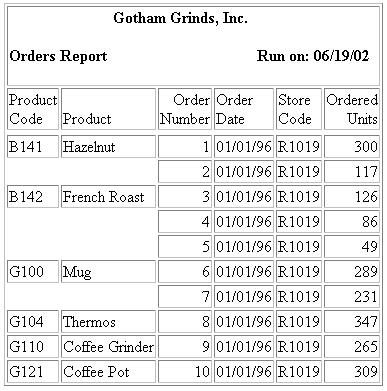
In the following request against the GGORDER data source, the subfooting has a text object ("Total") and a field object (ST.QUANTITY). The subfooting aligns the items with their report columns using TYPE=SUBFOOT, HEADALIGN=BODY ,$. The text object is placed in the second report column using the <+0 spot marker, and the field object is placed in the third report column using another <+0 spot marker. Then the text item is left aligned (the default) with its report column. The field object is right aligned with its report column:
TABLE FILE GGORDER PRINT QUANTITY ORDER_NUMBER ORDER_DATE STORE_CODE BY PRODUCT_CODE BY PRODUCT_DESCRIPTION WHERE ORDER_DATE EQ '01/01/96' WHERE STORE_CODE EQ 'R1019' ON PRODUCT_CODE SUBFOOT " <+0 Total: <+0 <ST.QUANTITY" ON TABLE SET PAGE-NUM OFF ON TABLE PCHOLD FORMAT PDF ON TABLE SET STYLESHEET * TYPE = SUBFOOT,HEADALIGN=BODY, $ TYPE = SUBFOOT,OBJECT=TEXT,STYLE = BOLD, $ TYPE = SUBFOOT,OBJECT=FIELD,JUSTIFY=RIGHT,STYLE = BOLD, $ ENDSTYLE END
The output shows that the text Total is aligned with the product names and the subtotal field object is right aligned with the Ordered Units column.

When aligning heading elements with the data line using HEADALIGN=BODY, the first row of fields serves as the anchor data row. Each heading line contains the number of columns presented in the anchor data row. Any additional columns that may appear on other data lines are not presented. If the first row of data contains fewer data value cells than other data rows, you will be unable to add alignment columns within headings for these additional columns.
In the following example, the first row (the anchor data row) contains a single value. Items placed in headings to correspond with column two that appears on subsequent rows are not displayed
SET LAYOUTGRID=ON TABLE FILE GGSALES "Product<+0>" "Units<+0>Dollars" SUM PRODUCT AS '' OVER UNITS/D8C AS '' DOLLARS/D12.2CM AS '' BY PRODUCT NOPRINT ON TABLE PCHOLD FORMAT PDF ON TABLE SET STYLE * TYPE=REPORT, SQUEEZE=ON,FONT=ARIAL, SIZE=8, LEFTGAP=.1, RIGHTGAP=.1, GAPINTERNAL=ON, $ TYPE=REPORT, BORDER=ON, $ TYPE=HEADING, BORDERALL=ON, HEADALIGN=BODY, $ TYPE=HEADING, LINE=1, ITEM=1, COLSPAN=2, WIDTH=2, JUSTIFY=LEFT, $ TYPE=HEADING, LINE=2, ITEM=1, WIDTH=1, JUSTIFY=LEFT, $ TYPE=HEADING, LINE=2, ITEM=2, WIDTH=1, JUSTIFY=LEFT, $ TYPE=REPORT, COLUMN=PRODUCT(2), SQUEEZE=2, $ TYPE=REPORT, COLUMN=UNITS, SQUEEZE=1, $ TYPE=REPORT, COLUMN=DOLLARS, SQUEEZE=1, $ END
The output shows that the heading lines have one column each, while the data lines alternate between one column and two columns:

